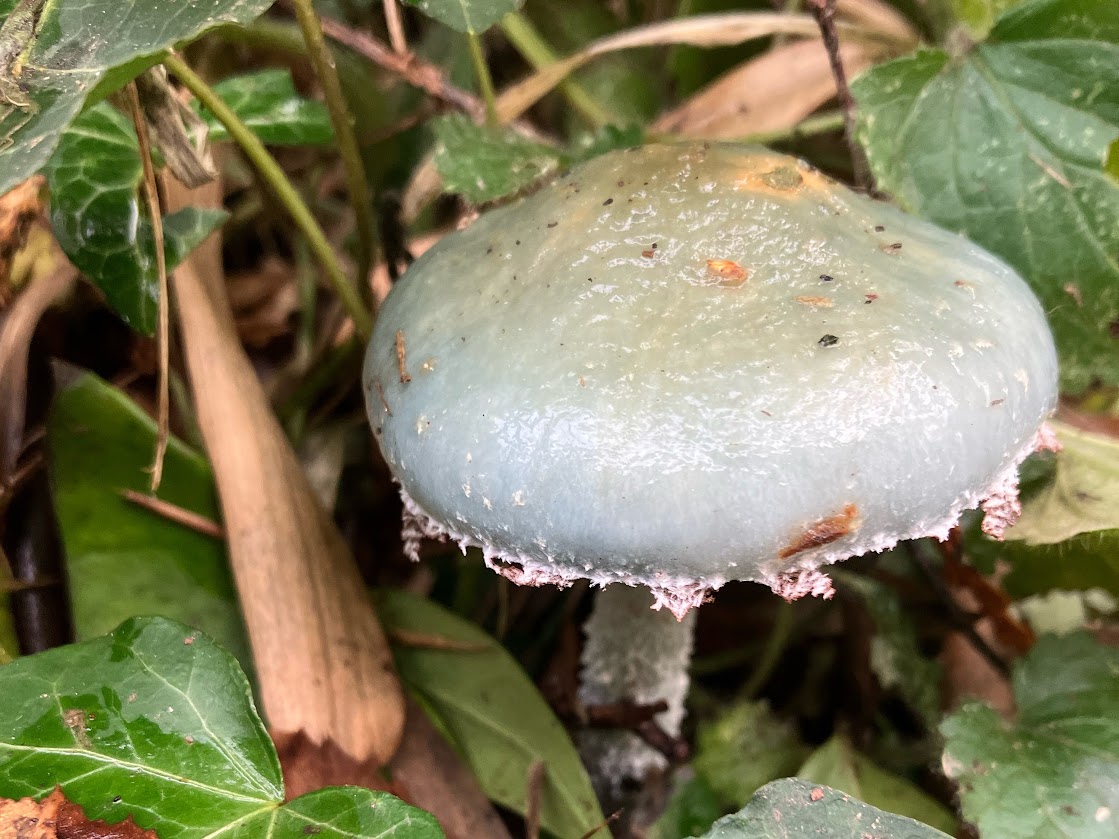Verdigris Agaric
26 November 2023

Searching for Cyclamen in the leaf-litter, I catch sight of a chip of plastic – turquoise or cyan, like Playmobil, some relic of a toy broken decades ago and lost to the undergrowth. Annoyed by its persistence and refusal to decay, I reach down to pick it up and am repelled by a viscid glisten. Moving the curling leaves of a Red deadnettle aside I see it is nothing manmade at all - but the startling dome of a mushroom.
Sprung up from the mixed mulch of conifer and Wild cherry, this solitary fruiting body leans at angle, peering out past the greenhouse, down the garden path. Something of its patina reminds me of a Hinkypunk, the green-blue sprites that reside in wetlands to lure travellers into bogs. It is too sturdy for a true Will-o’-the-wisp, and seems very firmly anchored in the earth, despite looking more alien than anything else in the vicinity. On close inspection I am revolted by its gelatinous covering – grit, seeds, particles of leaf, all manner of things are stuck to its surface. When I try to remove them with a stick, mucoid strings that would give pride to a slug stretch and snap back. It should be beautiful, this natural verdigris, reminiscent of oxidized copper rooftops in ancient cities. Instead, it is repellent; even without the slime, there is nothing in this mushroom that makes you want to touch it.
With absurd attention to detail, it is speckled white and fringed, like a tasselled parasol. Already turning brown in places, the tarnish marks its age and suggests it has been here for at least a few days. At about six inches in diameter, it is certainly a sizable meal for a bird or a squirrel and yet no one attempts to eat it. I wonder how far the rest of the organism stretches underground, and if other fruiting bodies will turn up. I watch over the next couple of weeks, but they never appear. It slowly collapses into the mulch, merging with the chippings, and I regret that if there was ever a moment when it sent out its spores, I definitely missed it.
Curiously, if you look up Stropharia aeruginosa on the Internet it seems the jury is out on whether or not it is poisonous. If you look up Stropharia aeruginosa in a guidebook it clearly states that it is. How anything so undesirable could ever be considered edible is a mystery; every aspect of this other-worldly organism tells you it cannot be human food. Added to this, among the fungi-friends there is a general assumption that anything slimy is best avoided, tending as it does towards toxicity.
As a natural object to view, Verdigris Agaric is beautiful in its way, and a charming symptom of a damp autumn. A cold mycelial blue alongside the hot pink petals of the Cyclamen. More vivid and vital than the inert plastic shards my eye is now trained to see.
